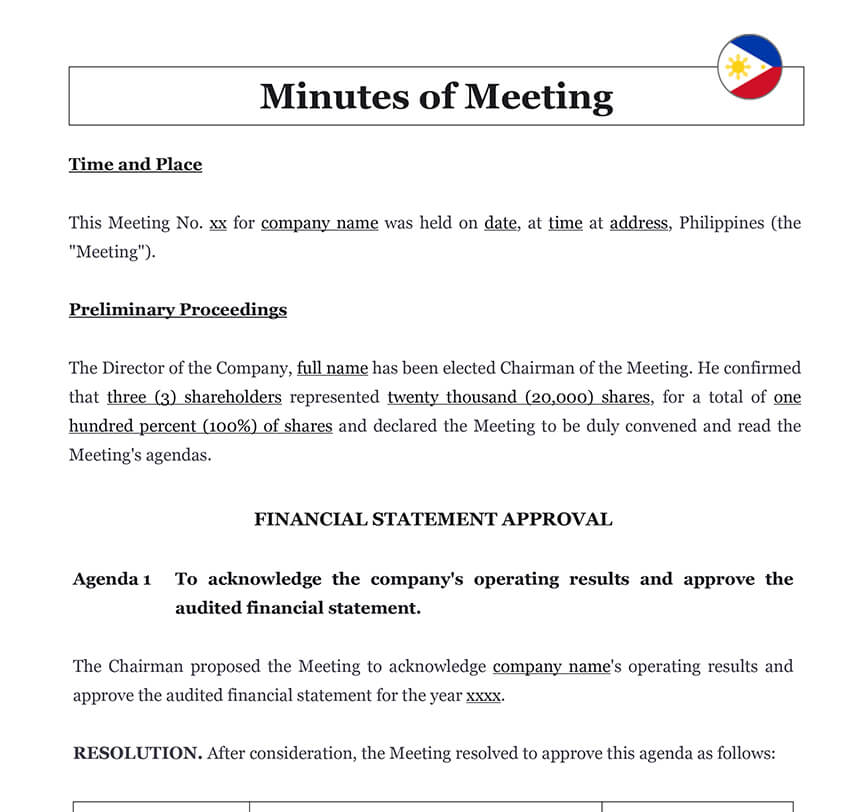Ready to use legal template
Drafted by experienced lawyers
Compliant with Filipino law
Ready to use legal template
Drafted by lawyers
Compliant with Filipino law
Home › Business contracts › Minutes of Meeting
Learn more about Minutes of Meeting in Philippines
Minutes of Meeting are official written records that summarize the discussions, decisions, and actions agreed upon during a meeting. They serve as a reference point for participants and stakeholders, helping to track progress, ensure accountability, and provide legal proof of resolutions made. In the Philippines, maintaining accurate meeting minutes is essential for corporate governance, compliance with the Revised Corporation Code, and documentation in both private and public organizations. Well-prepared minutes can protect against disputes and misunderstandings, especially for board meetings, shareholder assemblies, or committee sessions. Download our Minutes of Meeting template available in an easy-to-edit Word format, and professionally drafted to meet local legal standards in the Philippines.
Table of contents
What is an Annual General Meeting (AGM)?
What is the difference between an AGM and an EGM?
What are Minutes of Meeting?
What are the steps for taking minutes of a meeting?
What is the purpose of meeting minutes?
Who can write the minutes of meeting?
Is it possible to correct the meeting minutes afterwards?
What is an Annual General Meeting (AGM)?
The convening of the annual general meeting is a legal requirement. It occurs no later than six months following the conclusion of the company’s fiscal year. During an AGM, the company’s colleagues or shareholders meet to examine the annual accounts, discuss the previous year, and plan future projects. Each approved decision is put to the partners for a vote.
What is the difference between an AGM and an EGM?
The distinction between an ordinary and exceptional general meeting is based on the frequency of organization and the issues covered. The organizing of these two events remains largely the same.
The extraordinary general meeting allows a company’s shareholders to assemble to resolve an urgent and substantial matter. It contrasts from the AGM, which is held on a regular basis and allows for decisions on the yearly accounts. The agenda of an EGM does not deal with day-to-day operation of the firm, but with a significant and decisive change that affects the company or its members.
What are Minutes of Meeting?
Meeting minutes are meeting notes that serve as the meeting’s official record. Meeting minutes serve to provide a broad structure and to reinforce the goal of a meeting. They serve as a meeting template to determine the agenda before a group meets, as well as a written record of the meeting after it has occurred.
What are the steps for taking minutes of a meeting?
Taking meeting notes involves strong listening skills, attentiveness, and the ability to speak coherently. To learn how to take meeting minutes, follow this step-by-step guide:
1. Consider who will be present:
Before creating an agenda or even deciding on a time for the meeting, consider who will be in attendance. Make a list of everyone who will be attending, including their complete names and job titles or responsibilities in your organization. This will assist you in determining whether they require a unique agenda item suited to them or their department.
2. Create a meeting agenda:
A great meeting is a productive meeting, and planning the agenda ahead of time may help to assure productivity. A meeting agenda may help you keep conversations on course, address the concerns of all meeting attendees, and guarantee that all responsibilities have been allocated before the next meeting date.
3. Make a template available to attendees:
It might be helpful to offer a meeting minutes template with bullet points from this agenda to all attendees so they can take their own notes and, if required, follow up on any due dates or action items supplied. In this initial form, including a recap of the prior meeting minutes also helps frame the current agenda.
4. Take real-time notes:
As the designated note-taker, it is your obligation to document all relevant and crucial information as the meeting unfolds. This includes vote results, given duties, and choices that affect the entire team or company. Don’t stress about noting everything verbatim—meeting minutes are more about capturing the substance of what happened.
5. Fill in the blanks with notes:
After the meeting, read through your notes and build on the basic chronology of what you’ve written into a more legible, expressive, and thorough summary of what was said. This might assist participants recall crucial information long after the event has ended, or it can serve to update anybody who was unable to attend.
6. Hand out the notes:
When you’re satisfied with the final minutes, give them to your other attendees. Because a paper copy of everything said at the meeting is now on record and accessible at all times, they will be able to rely on your efforts to carry out their own action items.
What is the purpose of meeting minutes?
Minutes recorded in compliance with the rules of the Companies Act are admissible in court. For example, the only method to establish that a resolution of the corporation’s board of directors was approved is to provide the minutes in which the particular resolution was recorded in court.
Who can write the minutes of meeting?
In reality, the minutes might be prepared by a secretary or any other person assigned to the task. It is therefore a private record that serves as a basic verification of the accuracy of the material included in the usual general assembly minutes. In summary, the information contained in the general meeting minutes is presumed to be correct unless proven otherwise. It is advisable to be happy with a private document to facilitate the procedure of the general assembly.
The minutes of the general assembly can also be made out on the request of a public or ministerial authority in order to make it a genuine act that serves as incontrovertible confirmation of the accuracy of the material included.
However, it is recommended to retain the services of a legal practitioner to verify that the document issued is accurate and indicative of the general meeting. The specialist lawyer may also attend the regular meeting in order to rapidly draft the minutes.
Is it possible to correct the meeting minutes afterwards?
The minutes of the ordinary general meeting can be amended with additions, deletions, and rectifications. It is advised that a specific formalism be followed in order for the deed to remain legal after correction:
When words or paragraphs are removed or added, it is best to make references in the margin, i.e. to place an asterisk at the location of the error or omission and to declare in the margin that the element is removed or added.
Any revisions to the AGM minutes must be initialed by the original signatories of the meeting minutes; towards the conclusion of the meeting minutes, all adjustments must be summarized and signed by the initial signatories.
However, because the meeting minutes are not a genuine act, failure to follow the repair process outlined above does not necessarily result in the nullity of the minutes. In the case of a disagreement, the judge may make his own conclusion on the correctness of the general assembly minutes’ revisions.
SPECIAL OFFER
Startup
15 Document Package
Essential documents for running your business in the Philippines
Share information
Why Themis Partner ?
Make documents forhundreds of purposes
Hundreds of documents
Instant access to our entire library of documents for Philippines.
24/7 legal support
Free legal advice from our network of qualified lawyers.
Easily customized
Editable Word documents, unlimited revisions and copies.
Legal and Reliable
Documents written by lawyers that you can use with confidence.




